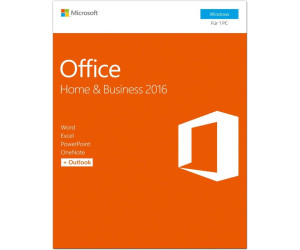

- #MICROSOFT HOME AND BUSINESS 2016 VS PROFESSIONAL INSTALL#
- #MICROSOFT HOME AND BUSINESS 2016 VS PROFESSIONAL PRO#
- #MICROSOFT HOME AND BUSINESS 2016 VS PROFESSIONAL PLUS#
- #MICROSOFT HOME AND BUSINESS 2016 VS PROFESSIONAL DOWNLOAD#
- #MICROSOFT HOME AND BUSINESS 2016 VS PROFESSIONAL FREE#
You can use ExcludeApp element in configuration.xml to remove Access application when installing.
#MICROSOFT HOME AND BUSINESS 2016 VS PROFESSIONAL PLUS#
If you pick the plan and don't want Access to be installed, you couldĭeploy Office Professional Plus 2019 via the ODT.
#MICROSOFT HOME AND BUSINESS 2016 VS PROFESSIONAL INSTALL#
Unfortunately, it's true that we can't install Office 2019 and Skype for Business 2016 in the same computer because they share the same version 16.0 and use different installation technologies.įor the volume licensed version of Office 2019, only Office Professional Plus 2019 includes Skype for Business. But if not, how do I get Office 2019 with some version of Skype for Business on the same computer?
#MICROSOFT HOME AND BUSINESS 2016 VS PROFESSIONAL DOWNLOAD#
My next effort will be to try to download & install Skype for Business 2016īasic.
#MICROSOFT HOME AND BUSINESS 2016 VS PROFESSIONAL PRO#

Scenarios: the entire office (~50 computers) has Office 2013 Standard with Skype for Business 2016. The Student suite also comes with technical support, but only for 90 at the MSI vs click-to-run vs retail installation woes.
#MICROSOFT HOME AND BUSINESS 2016 VS PROFESSIONAL FREE#
The Professional suite comes with a free one year technical support so you can just call Microsoft’s techs whenever you have a problem with MS Office. The last difference between the two comes in the form of technical support from Microsoft. The Student suite only retails for about $149 while the Professional suite adds $350 for a whopping $499 retail price more than three times the price. If you have no need for the three applications mentioned above, you can slash a huger amount from the purchase price of MS Office. With the general applications like Word, you get all the functionalities and there are no restricted or missing features. They are not really very essential and majority of students have no need for any of these applications. The three applications mentioned above are the only things that you do not get with Student. This is very useful in creating publications, whether it just for your office or for the general public. Publisher is pretty similar to Word but it gives prime focus on how you layout the elements like text and pictures on a page. Quite naturally, Access is very useful to people who are working in companies that use databases to keep track of all their data. These are often used to keep track of inventories, subscribers, and the like in businesses. This is appropriate for working peole with busy schedules who regularly connect to Outlook servers for their mails and not students.Īccess is a database management tool that lets you create, modify, or just look-up databases. Outlook is an application that handles your email and schedules so that you are always informed on what’s happening and plan your activities accordingly. But Student doesn’t have the Outlook, Access, and Publisher applications that you would otherwise find in the Professional. Both have the basic applications like Word, Excel, Powerpoint, and OneNote. The main difference between the Student suite and the Professional suite is the applications that they come with.

Microsoft’s Office suite of productivity applications comes in a variety of packages or suites.


 0 kommentar(er)
0 kommentar(er)
